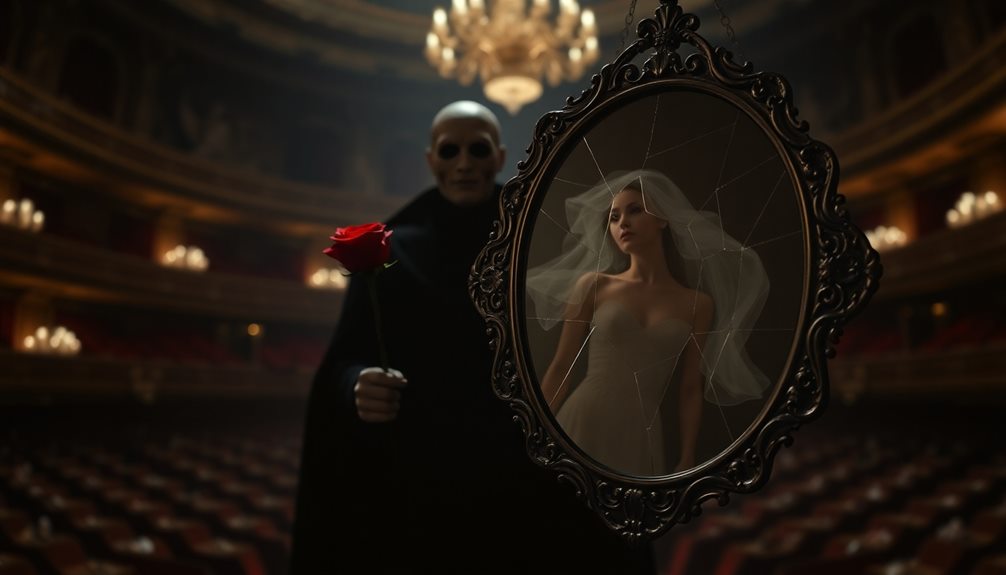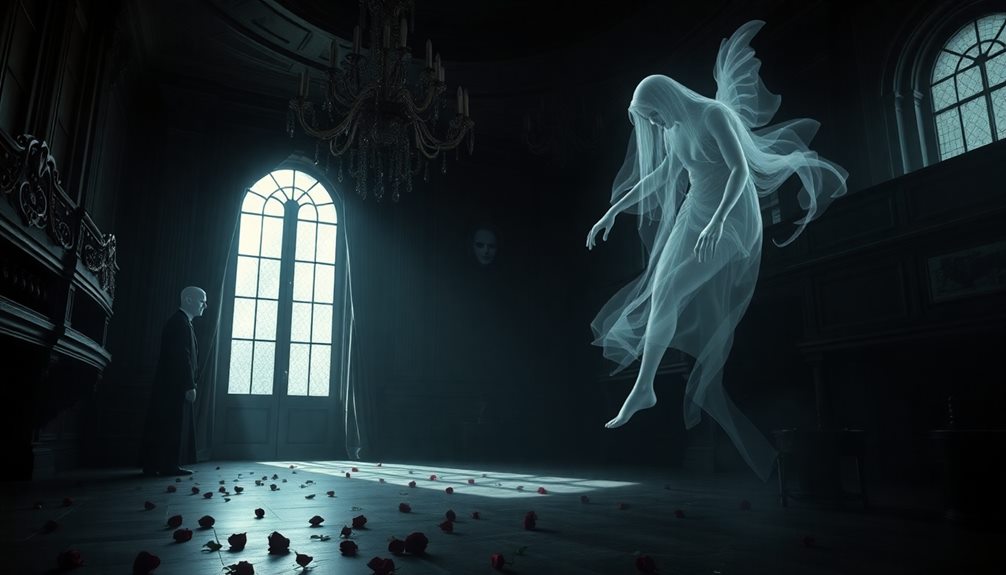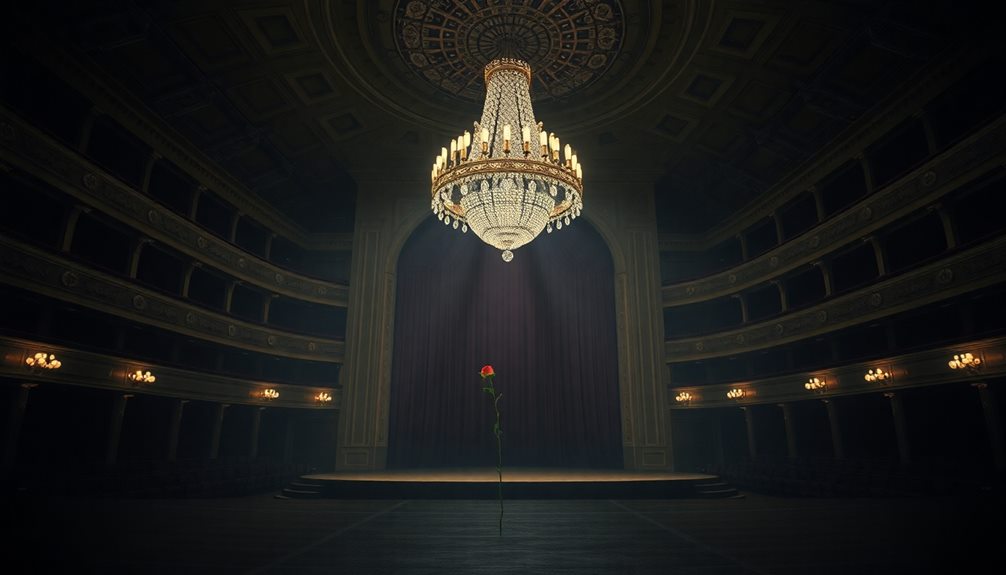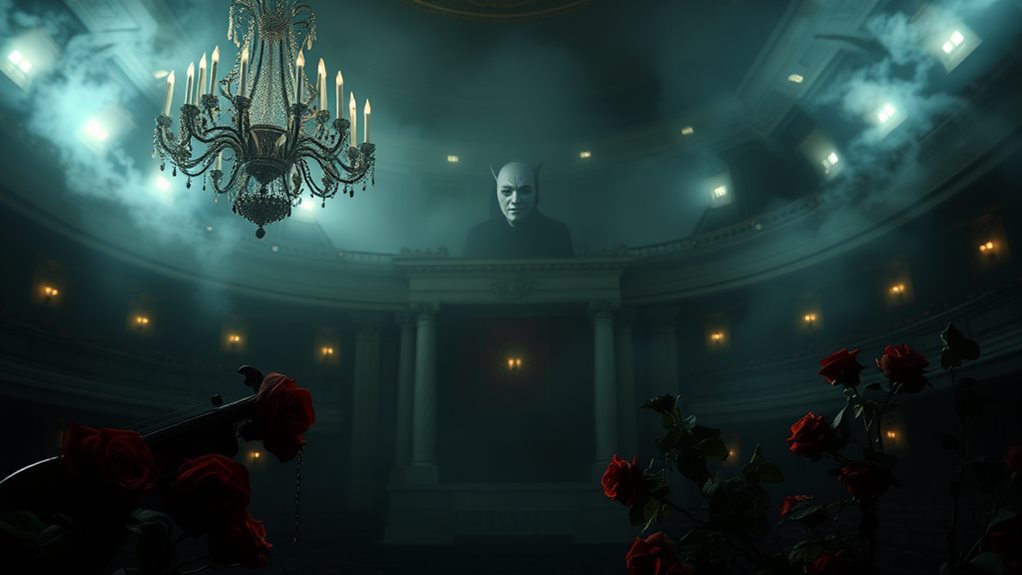In Gaston Leroux's "The Phantom of the Opera," you'll uncover how love, madness, and mystery intertwine to shape the story's haunting narrative. Christine's emotional turmoil between the obsessive Phantom and the protective Raoul highlights the duality of affection and madness. You'll see Erik's tragic obsession with Christine evolving into violence, revealing the darker side of love. The eerie atmosphere of the Paris Opera House adds layers of mystery, blurring the line between reality and the supernatural. This complex interplay ultimately critiques societal standards of beauty and worth, inviting you to explore deeper themes and character dynamics.
Overview of the Novel
Have you ever wondered how a tale can blend horror, romance, and mystery so seamlessly? "The Phantom of the Opera," penned by Gaston Leroux in 1910, is a quintessential gothic novel that captivates readers with its haunting narrative.
Set in the majestic Palais Garnier, the Paris Opera House, during the early 1900s, this story immerses you in a world filled with eerie shadows and emotional complexities, enriched by the opera house's haunting atmosphere.
At the heart of the tale is Christine Daaé, a gifted soprano whose exceptional talent draws the attention of the enigmatic Phantom, Erik. As you explore the narrative, you'll witness Christine caught in a tumultuous love triangle between the Phantom and her childhood friend, Raoul de Chagny.
Their struggles reveal deeper themes of obsession and societal rejection, reflecting the duality of beauty and monstrosity.
Leroux's vivid descriptions create an atmospheric backdrop that heightens the tension and intrigue surrounding the Phantom's actions. The gothic elements not only enhance the story's chilling essence but also serve as a powerful commentary on the nature of love, madness, and the human condition, making "The Phantom of the Opera" an unforgettable literary experience.
Character Analysis
In "Phantom of the Opera," you see how Erik's tragic obsession with Christine drives him to extremes, revealing the darker sides of love.
This narrative echoes themes such as shame in love and the complexities of societal expectations that Baldwin explores in "Giovanni's Room."
Christine grapples with her emotional turmoil as she navigates between Erik's intense passion and Raoul's protective nature.
This conflict highlights the tension between desire and safety, making their relationships complex and compelling.
Phantom's Tragic Obsession
Erik, the Phantom, stands as a haunting figure, embodying tragic obsession through his all-consuming desire for Christine Daaé. His relentless pursuit is driven by profound loneliness and a desperate need for love and acceptance, despite his deformity.
You can see how this obsession manifests in various ways:
- Manipulation: Erik intimidates and controls Christine's choices, revealing his possessive nature.
- Violence: His actions turn violent when he perceives threats, particularly towards Raoul.
- Artistry: The power of music highlights the duality of Erik's character; he's both a brilliant artist and a tragic figure.
- Isolation: His past as an outcast fuels his need for vengeance, showing how deep emotional pain can lead to obsession.
Ultimately, the Phantom's tragic obsession leads to self-destructive choices, exposing the horrific consequences of love turned possessive.
It's a stark reminder of how the inability to connect meaningfully with others can spiral into madness.
Erik's journey serves as a cautionary tale about the dangers of obsession and the devastating toll it can take on both the seeker and the object of desire.
Christine's Emotional Turmoil
Caught in the web of Erik's obsession, Christine Daaé faces her own emotional chaos as she grapples with conflicting feelings for both the Phantom and Raoul. This love triangle creates intense emotional turmoil within her, as she oscillates between fear and affection.
On one hand, there's Raoul, representing safety and genuine love; on the other, there's the Phantom, whose possessiveness and darkness draw her in yet terrify her.
Christine's transformation from a naive girl to a woman confronting the complexities of love and obsession reveals her vulnerability and desire for autonomy. Erik's overwhelming presence fosters a sense of entrapment, complicating her emotional landscape and making her question her feelings.
The societal pressures surrounding beauty and talent amplify her struggles, as she navigates the competitive dynamics of the opera house, feeling the weight of expectations on her shoulders.
Ultimately, Christine's journey encapsulates the broader themes of love, madness, and the search for identity. Her emotional turmoil reflects a universal struggle, highlighting the human experience when faced with overwhelming circumstances, making her a deeply relatable and poignant character.
Themes of Love and Obsession

Love and obsession intertwine in a way that can lead to both beauty and destruction, as seen in the tumultuous relationships within "The Phantom of the Opera." The intense love triangle involving Christine Daaé, the Phantom, and Raoul de Chagny reveals how deep feelings can warp into dangerous fixations.
Erik's obsession with Christine drives him to possessive and violent behavior, contrasting sharply with Raoul's more conventional and nurturing love. This dynamic mirrors the psychological explorations found in works like Rebecca by Daphne Du Maurier, where themes of envy and hidden truths also play a significant role.
Consider these elements of love and obsession in the narrative:
- Erik's fixation leads to intimidation and even murder, highlighting the destructive potential of unreciprocated love.
- Christine's struggle to choose between the Phantom's dark allure and Raoul's gentler affection illustrates the complexities of desire and agency.
- Obsession serves as a double-edged sword, with Erik's musical genius overshadowed by his violent tendencies and societal rejection.
- The emotional turmoil resulting from these relationships paves the way for tragic consequences, ultimately leading to loss and heartbreak.
In "The Phantom of the Opera," love and obsession reveal the fine line between passion and madness, showcasing the devastating impact of unchecked emotions.
The Natural vs. the Supernatural
In "The Phantom of the Opera," you encounter a world where ghostly phenomena often have rational explanations lurking beneath the surface.
This interplay of reality and illusion mirrors the themes explored in Richard Wright's *Native Son*, where systemic oppression shapes individual experiences and actions.
As you explore the mysterious origins of haunting events, you'll find that what seems supernatural can often be tied to human emotions and actions, much like the struggles of a young Black man in a racially charged society.
This blend sparks your curiosity about the fine line between reality and the supernatural, inviting you to question what you believe.
Ghostly Phenomena Explained
The eerie atmosphere of the Paris Opera House in the 1880s captivates readers with ghostly phenomena that seem to blur the lines between the natural and the supernatural. As you explore deeper into the story, you'll discover that many of these mysterious events, such as the death of Joseph Buquet and Christine Daaé's musical transformation, have roots in human behavior and societal dynamics.
Consider these key aspects of the narrative:
- Fear and Fascination: Characters are drawn to the Phantom, revealing their complex emotions.
- Illusion vs. Reality: The story challenges your perception of what's real and what's imagined.
- Human Behavior: Society often attributes the unknown to supernatural causes, showcasing human tendencies.
- Erik's Tragic Existence: The blend of natural explanations with Erik's tragic life adds depth to the ghostly phenomena.
Ultimately, the blending of natural explanations with supernatural elements enhances the intrigue of the novel. It invites you to question the true nature of the Phantom's existence and influence, emphasizing how fear can distort reality, leading to the creation of myths surrounding individuals like Erik.
Reality Behind Haunting Events
Many haunting events at the Paris Opera House initially appear supernatural, but a closer look reveals their roots in human emotions and actions. The death of Joseph Buquet, for example, seems to echo ghostly involvement, yet it's steeped in jealousy and the complexities of human relationships.
As you explore deeper into these occurrences, you realize that the tension between the Phantom and the characters stems from their own inner turmoil, rather than otherworldly forces.
Erik's mastery of music and sound creates an unsettling atmosphere, making it hard to distinguish between reality and the supernatural. This manipulation blurs perceptions, leading both characters and audiences to question their understanding of events.
You'll notice that the eerie occurrences often reflect the characters' struggles with isolation, obsession, and fear.
Ultimately, the novel suggests that what's deemed haunting is a mirror of the characters' internal battles and societal issues. The supposed ghostly actions are rooted in tangible human experiences, prompting you to reconsider the nature of fear and madness in the face of love and longing.
In this way, the narrative elegantly intertwines reality with the supernatural, enhancing its intrigue.
Mysterious Origins Uncovered
Amidst the grandeur of the Paris Opera House, mysterious events unfold that challenge your perception of reality and the supernatural. As you explore Erik's past, you uncover a web of human emotions and motivations that give rise to these enigmas.
Initially, you might think ghostly forces are at play, especially with incidents like Joseph Buquet's death and Christine Daaé's extraordinary transformation. However, an investigation reveals that many occurrences have natural explanations shaped by human behavior.
Consider the following elements that intertwine the natural and supernatural:
- The death of Joseph Buquet: A tragic event steeped in human conflict rather than ghostly intervention.
- Christine Daaé's transformation: A reflection of ambition and obsession, not merely magic.
- Erik's manipulative actions: Rooted in deep emotional scars, driving his obsession with Christine.
- Societal dynamics: The backdrop that influences characters' choices and perceptions.
This blending of realities invites you to question the essence of truth. By exploring these mysterious events, you'll find that the line between the natural and supernatural is often blurred, revealing profound insights into love and madness.
Violence and Redemption

Rooted in a traumatic past, Erik's violent tendencies unfold throughout *The Phantom of the Opera*, revealing the deep scars left by his experiences as an assassin and societal outcast. His life is marked by violence, as he resorts to intimidation, blackmail, abduction, and even murder to exert control over those who've dismissed him. Each act of aggression stems from his profound pain, showcasing a man desperate for recognition and acceptance, much like the characters in *The Book Thief* who endure immense challenges under oppressive regimes and seek solace in acts of defiance against evil acts of defiance highlight the theme of courage.
However, beneath this cycle of violence lies a flicker of redemption, primarily illustrated through his misguided love for Christine. You see, Erik's feelings for her expose his vulnerability, suggesting that he longs for connection rather than fear.
When Christine ultimately rejects him, it signifies a pivotal moment that not only highlights the futility of his violent actions but also opens the door for potential emotional transformation.
Even as Erik embodies monstrous behavior, his complexity as a character reveals that he's capable of deep emotional longing. This juxtaposition of violence and redemption ultimately invites you to reflect on the possibility of change, urging you to contemplate that even the most tormented souls can seek a path toward acceptance and love.
Beauty and Ugliness
Erik's grotesque appearance serves as a powerful symbol of the struggle between beauty and ugliness in *The Phantom of the Opera*. His disfigured face repulses society, leading to intense isolation and rejection. This contrast starkly highlights how societal standards often prioritize superficial beauty over genuine talent, much like the social realities depicted in Charles Dickens' *David Copperfield* that expose class struggles and personal growth through adversity (enduring strength found in perseverance).
While Erik's inner beauty shines through his exceptional musical abilities, it remains overshadowed by his outer ugliness.
Consider these key points:
- Erik represents the tragic consequences of societal rejection due to appearance.
- Christine Daaé embodies the ideal of beauty, complicating her relationships.
- The novel critiques cultural preferences for aesthetic appeal over true worth.
- Erik's madness stems from his longing for acceptance despite his looks.
Through Erik's experiences, Leroux explores the devastating effects of valuing beauty over authenticity. It prompts you to question the nature of love and attraction: can you truly love someone whose appearance society deems unworthy?
Ultimately, the themes of beauty and ugliness resonate throughout the narrative, revealing the harsh realities of how society can shape individual destinies.
Isolation and Loneliness

Isolation and loneliness permeate the narrative of *The Phantom of the Opera*, vividly illustrated through Erik's tragic existence. Living in the opera house's depths, Erik embodies the extremes of isolation, forced to retreat from society due to his disfigured appearance and haunting past. His loneliness drives him to desperate actions, seeking connection through an obsessive love for Christine Daaé, who herself grapples with her own form of isolation.
This poignant struggle reflects the universal quest for stability amidst chaos, akin to the characters in the search for identity in *Navigating Through A Fine Balance*. Torn between her feelings for Erik and Raoul, Christine often feels trapped and misunderstood, echoing Erik's sentiments.
The opera house serves as a powerful metaphor for their isolation, with its labyrinthine passages and hidden corners reflecting not only the characters' physical seclusion but also their emotional detachment from the world.
Leroux artfully emphasizes the emotional consequences of such isolation, showcasing how it can lead to manipulation and extreme behaviors in a desperate quest for acceptance and love. Both Erik and Christine's experiences illustrate that isolation can warp human connection, pushing individuals towards darkness and despair, ultimately revealing the profound need for understanding and companionship in a world that often rejects them.
Social Commentary and Critique
The themes of isolation and loneliness in *The Phantom of the Opera* naturally lead to a broader critique of societal norms and values. Through Erik's tragic story, you see how society's rigid standards of beauty cast aside those who don't fit its mold. This critique is evident in several ways:
- Erik's talent is overshadowed by his disfigured appearance, highlighting society's injustices against the "ugly." The narrative resonates with the concept of the triumph of the human spirit, as Erik's artistic abilities clash with societal rejection.
- The opera house serves as a microcosm of social class dynamics, where wealth trumps talent, revealing a corrupt artistic meritocracy.
- Christine Daaé's struggle illustrates the pressures women face, torn between the Phantom's obsession and Raoul's socially acceptable love.
- Erik's madness, stemming from societal rejection, showcases the destructive consequences of isolation and obsession.
These elements culminate in a narrative that intricately reflects the complexities of love and societal pressures. The fates of Christine, Erik, and Raoul reveal that true acceptance is often unattainable, as the characters navigate a world that prioritizes appearance and status over genuine connection.
Ultimately, Leroux's work serves as a poignant reminder of the madness that can arise from a society unwilling to embrace difference.
Conclusion
In "The Phantom of the Opera," you plunge into a world where love and madness intertwine like the threads of a tragic tapestry. Just as Orpheus descended into the underworld for his muse, you witness the lengths one will go to for love, revealing the thin line between devotion and obsession. The haunting melodies resonate long after the final curtain falls, leaving you to ponder: in the pursuit of beauty, how often do we confront our own inner demons?



